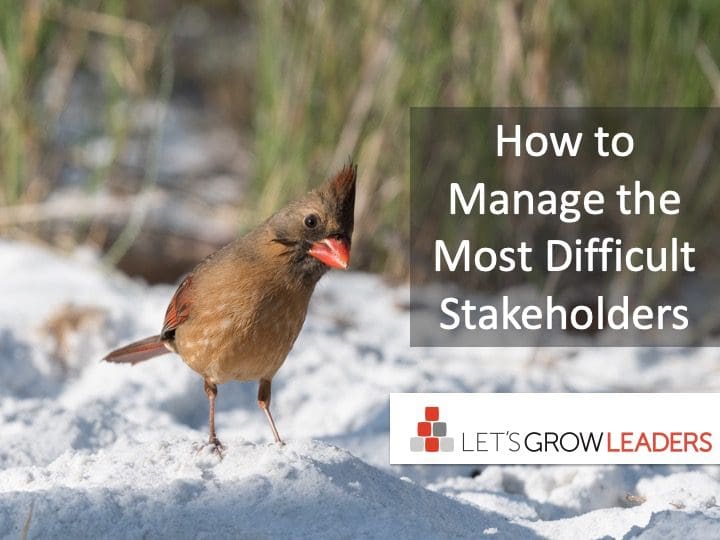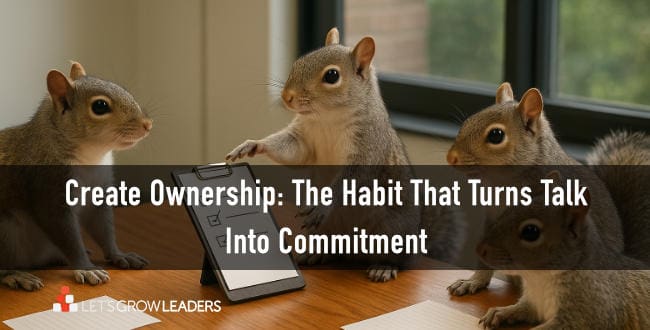Difficult stakeholders are a chance to grow your influence.
You look at the phone and your heart sinks. It’s the night before you’re supposed to wrap up your assignment and brief the leadership team on what you’ve done. It’s Bruce, a charismatic VP –and one of your difficult stakeholders – calling.
You answer the phone and cringe as you hear, “Listen, I’ve had some thoughts about this project and it’s important that we get it right.”
You don’t disagree – you do need to get it right, but the time for this conversation was a week ago. Now you face telling a key stakeholder “no” or launching a major fire drill to incorporate all their suggestions, rewrite the presentation, and then deal with the fallout from other stakeholders who already shared their input.
The Reality of Difficult Stakeholders
Difficult stakeholders come in many flavors.
Where Bruce was difficult because he wasn’t involved soon enough, you’ve probably had stakeholders who were over-involved; who you informed, but they couldn’t process what you’d told them; who had a different agenda, but never revealed it; stakeholders who never understood what you were doing; others who were just – difficult.
Your success requires you to partner and collaborate with a wide range of people who have a stake in what you do. Navigate your difficult stakeholders well and you can build a career of influence and impact.
One Key Truth About Your Difficult Stakeholders
Nate was the President of a large urban school board. During a tumultuous time of change, David asked Nate for his thoughts on the controversies. Nate replied, “Well, schools are entrusted with people’s children and with people’s money. Those are two of the most important things to most folks. How could it not be controversial?”
This is an important perspective to keep in mind as you navigate your difficult stakeholders. Your work affects them and their success, so it’s natural that they will have concerns about what you do.
They’re not trying to be difficult. They’re trying to succeed.
How to Manage the Most Difficult Stakeholders
1. Choose Effective, Not Right
Leaders often get stuck because they can’t see past their own “rightness” and do the things that will help them be effective and get the results they want. You may have given Bruce a chance to have input earlier in the process, but clearly, it didn’t work.
If Donna’s feeling stressed and asks you for updates so often that it’s slowing down your work, then the way you’ve been communicating isn’t working. You may have been “right” in that you updated her, but you haven’t yet been effective.
Set aside right, and focus on how you can be effective with your difficult stakeholders.
2. Breathe
When you feel overlooked, slighted, ignored, devalued, or taken for granted it’s normal to be angry and ask “Why are they doing this to me?”
Take a moment to breathe and remind yourself that the other person’s actions aren’t about you. They’re trying to do the best they can with what they have. They didn’t wake up that morning thinking about how to make you angry.
If you need to take a few minutes to collect yourself, do it. You’re better off entering the conversation in a calm state of mind.
3. Find Empathy
Empathy is the most effective way to help you become more effective with your challenging stakeholders. Try to see the world from their perspective. When you can understand why they act the way they do, you are in a better position to come up with constructive solutions.
Perhaps Bruce is juggling three major strategic initiatives that consume his attention. He lives in the mental world of opportunity and “What could be” and doesn’t feel tied down by arbitrary due dates. He also cares – a lot.
Maybe Donna is a CEO looking at the bottom line and concerned about the volatility of your three biggest customers. Last summer you stuck with a supplier longer than you probably should have and quality suffered. She didn’t hear it from you but got a call from one of those big three customers asking what was going on.
If you’re not sure what the world looks like from their perspective, you can always ask. eg: “What is most important about this assignment? I want to make sure we nail it – can you help me understand how this fits into the big picture?”
4. Seek Self-Awareness
After empathy, this is another vital element of navigating your relationships with your difficult stakeholders. Moreover, they’re not the only “difficult” person in the mix. From their perspective, you might be the difficult one. As David is fond of saying, “We are all someone else’s knucklehead.”
We worked with a smart financial controller who was running into problems with key stakeholders because his answer to every question was an intricate, detailed, analytic exploration of twenty years’ history of the subject at hand. Naturally, his answers frustrated stakeholders who just wanted to know if the new policy would take a week or a month to implement.
The controller cared. He thought the background would be helpful to others the way it was helpful to him. When he realized how he was coming across, he could choose a different style.
5. Help Them Win
Once you know what your difficult stakeholders want, try to work with them in a way that helps them achieve their wins. Donna’s win is hanging onto those three customers. How does your work contribute to that outcome? How can you give her the confidence that you understand and are working to make that happen?
As Zig Ziglar famously said, “You will get all you want in life, if you help enough other people get what they want.”
6. Inform Intelligently
Different people need different information – differently. Remember, you want to be effective, not right. It does no good to send a monthly email when you know your key stakeholder receives information verbally and can give you a response quickly if you’ll just walk down the hall or pick up your phone.
Do they need the full backstory or a quick summary of what happened and what you need? Do they want hourly updates or a weekly summary? Give people the information they need in the way they need it and your relationship will improve.
This is where many leaders get caught in the trap of being “right” but not effective. Just because you sent an email doesn’t mean you’ve communicated. See how Karin learned this the hard way
7. Plan Engagement
When you know that a key stakeholder is likely to engage too late, too often, or not at all, you can plan an intentional way to get their attention and input.
For someone like Bruce, who you know will wait until the last minute to get involved, move the finish line. Specifically, seek him out eg “Bruce, can we talk for five minutes – you’ve got something valuable to offer here.” Tell him how much you value his perspective, and that you would love his input. If he doesn’t have thoughts now, give him a deadline that still allows you to get it done. This conversation is best in person or by phone/video conference.
Yes, it takes a little extra effort compared to the wiki where everyone else is contributing, but the alternative is that dreaded phone call the night before. Savvy leaders know their stakeholders and get them involved when it makes the most sense.
8. Ditch the Diaper Drama
If you’re new to this concept, we’re talking about getting real and speaking the truth.
Sometimes the best way to address a difficult stakeholder is to have a connected, real conversation. Some examples might include:
“I noticed that you withdrew your support for the decision we agreed to last week. I want to rely on our agreements with one another – I’m curious, what’s going on?”
“It seems like we might not be on the same page here. I want to make sure we both succeed here. I’m curious about what success looks like from your perspective?”
Your Turn
Navigating and managing difficult stakeholders takes empathy, awareness, and practice. This is where you can distinguish your leadership or descend into a whirlpool of frustration. Leave us a comment and share your best strategy for engaging with difficult stakeholders.
Join the Conversation on LinkedIn
Creative Commons photo by Russ







Fantastic points and the idea of choosing effective, not necessarily being right is so important. Your #4- Seek self-awareness is one that I use so often and encourage my clients to use. We each have different styles. Some of us want to receive information in longer stories while others of us just want bullet points. Knowing the best way to connect with a stakeholder will lead to an mutually successful outcome.
Thanks Karin!
Thanks so much, Terri. I always appreciate your insights. It’s been so interesting partnering with David as we have very different styles. Our goals are totally aligned, our values are aligned and yet we often approach problems and the information we think we need to solve them from completely different angles.